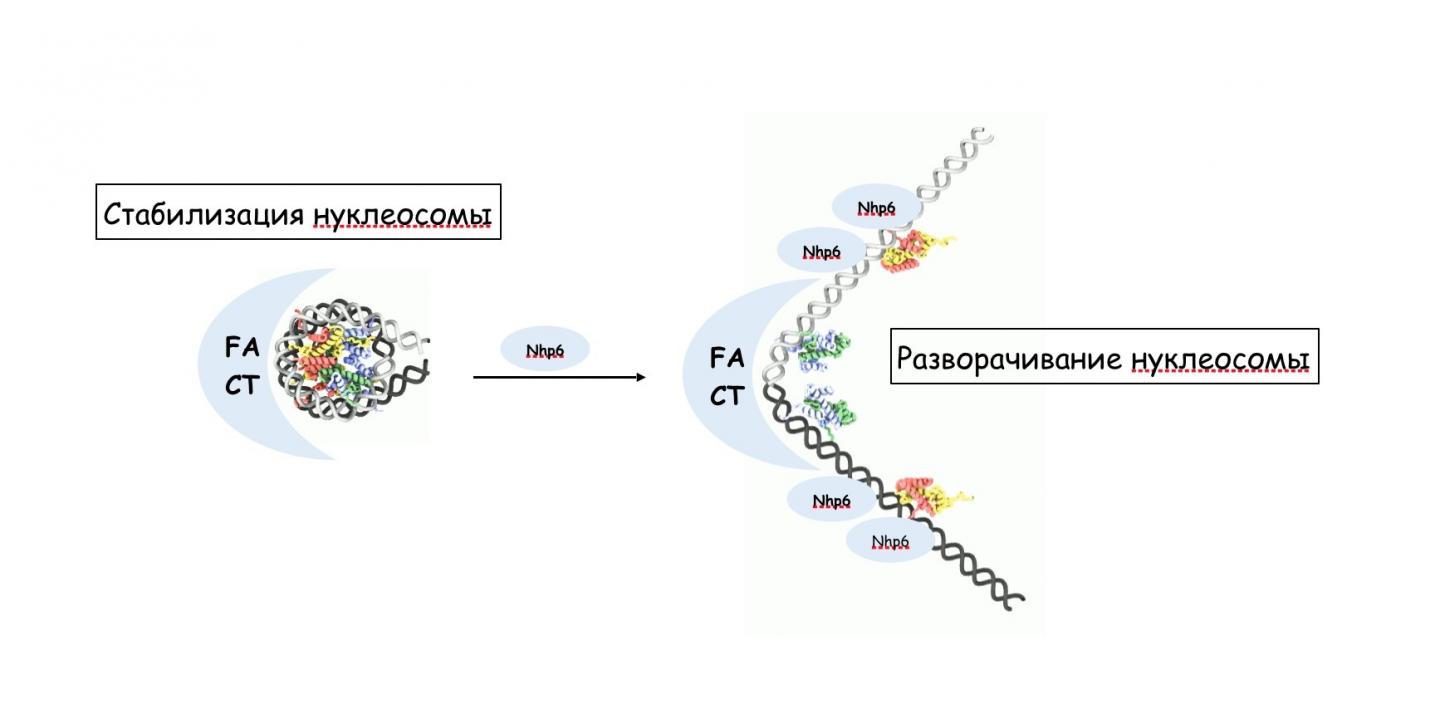
Credit: Maria Valieva
Today, scientists extensively study FACT – a protein complex that plays a role in DNA packing within a nucleus, as well as in oncogenesis. A team of scientists from MSU working in cooperation with foreign colleagues found out similarities between the work of this complex in humans and yeast. This discovery helped predict the existence of a new protein that assists the FACT complex in humans. An article about the study was published in Journal of Biological Chemistry.
In eukaryotes hereditary information is encoded in the DNA molecule that is about one meter long but is packed in the tiny nucleus. The DNA molecule is extremely thin, and if it were chaotically crumpled, it would be impossible to detangle it without damaging. In order for the genetic code to be read (and proteins to be synthesized based on it), it has to unfold, therefore in the course of evolution organisms got used to storing it in a space-efficient manner. Histones, the proteins that bind to DNA, help to pack the genome in the cell nuclei. This complex is called chromatin. A minimal unit of chromatin is called a nucleosome; chromatin looks like a sequence of sewing spools (nucleosomes) with two DNA loops tightly wrapped on each of them.
However, the work of this system also includes lots of other proteins. One of the protein complexes that control this process is called FACT (facilitates chromatin transcription). It secures more effective RNA reading from the DNA template packed in chromatin.
"On the molecular level yeast FACT can both stabilize nucleosomes in the genome during RNA reading and unfold nucleosomes," commented the co-author of the article Vasily Suditsky, the head of the laboratory for the regulation of transcription and replication of the Faculty of Biology, MSU, referring to his other works. "The balance between these two functions is determined by the presence of the yeast protein Nhp6 that helps FACT unfold nucleotides. Until recently, the second function was unknown for human FACT, despite a considerable similarity of structure of these protein complexes in yeast and humans."
Surprisingly, FACT straightens the DNA looped around the spools without any energy spent (energy is stored within cells and transferred in the form of ATP molecules). Before today, studies like that were conducted using yeast material. In the new article Vasily Suditsky and his colleagues analyzed the mechanism of operation of this complex in humans. They were the first to prove that the Nhp6 protein from yeast in combination with human FACT complex is able to unfold nucleosomes.
"The critical data were obtained at the Faculty of Biology, MSU using a modern biophysical approach – single-particle FRET (spFRET is a method that allows to measure interatomic distance within one DNA-protein complex)," – added Vasily Studitsky. "The information we received led to the assumption that humans may possess a homologue of the yeast protein Nhp6 helping FACT unfold nucleosomes and regulate gene transcription."
The team also found important differences between human and yeast FACT complexes, though the activity of both varieties appeared to be relatively similar. The scientists found out that in vitro (i.e. in a test tube) yeast FACT cannot work without Nhp6, but in vivo (in cells) it functions. However, in this case the functions of the FACT complex may be compensated with other proteins. Therefore, it is still unknown whether yeast FACT can function without Nhp6. On the contrary, human FACT is not stably associated with nucleosomes without additional proteins that haven't been studied in humans yet.
FACT complex is known to have been changing slowly during the evolutionary process (or, in the scientific terms, to be evolutionarily conserved). Scientists tried adding yeast Nhp6 to human FACT complex, and it helped it work. Therefore it can be assumed that humans also have a still unknown protein that helps FACT function.
"In the future we plan to search for this hypothetical Nhp6-like human protein and to determine the role of nucleosome unfolding by FACT in gene regulation and detection of regions with damaged chromatin structure in the genome," – added Vasily Studitsky, speaking about the prospects of the group.
###
Among the co-authors of the article were the scientists from Shemyakin and Ovchinnikov Institute of Bioorganic Chemistry of the Russian Academy of Science, University of Utah School of Medicine, and Fox Chase Cancer Center.
Media Contact
Yana Khlyustova
[email protected]
http://www.msu.ru
Related Journal Article
http://dx.doi.org/10.1074/jbc.RA117.000199





